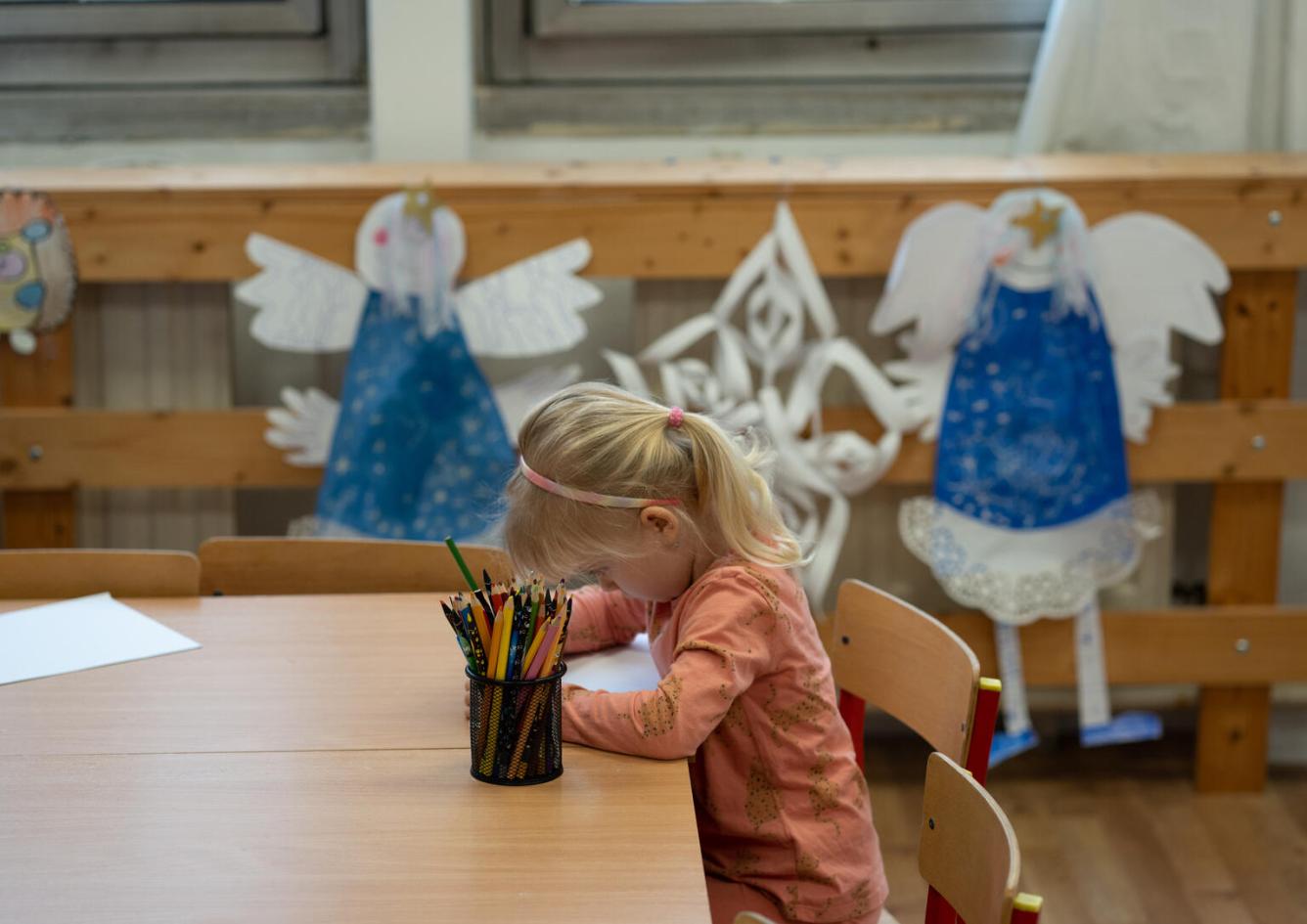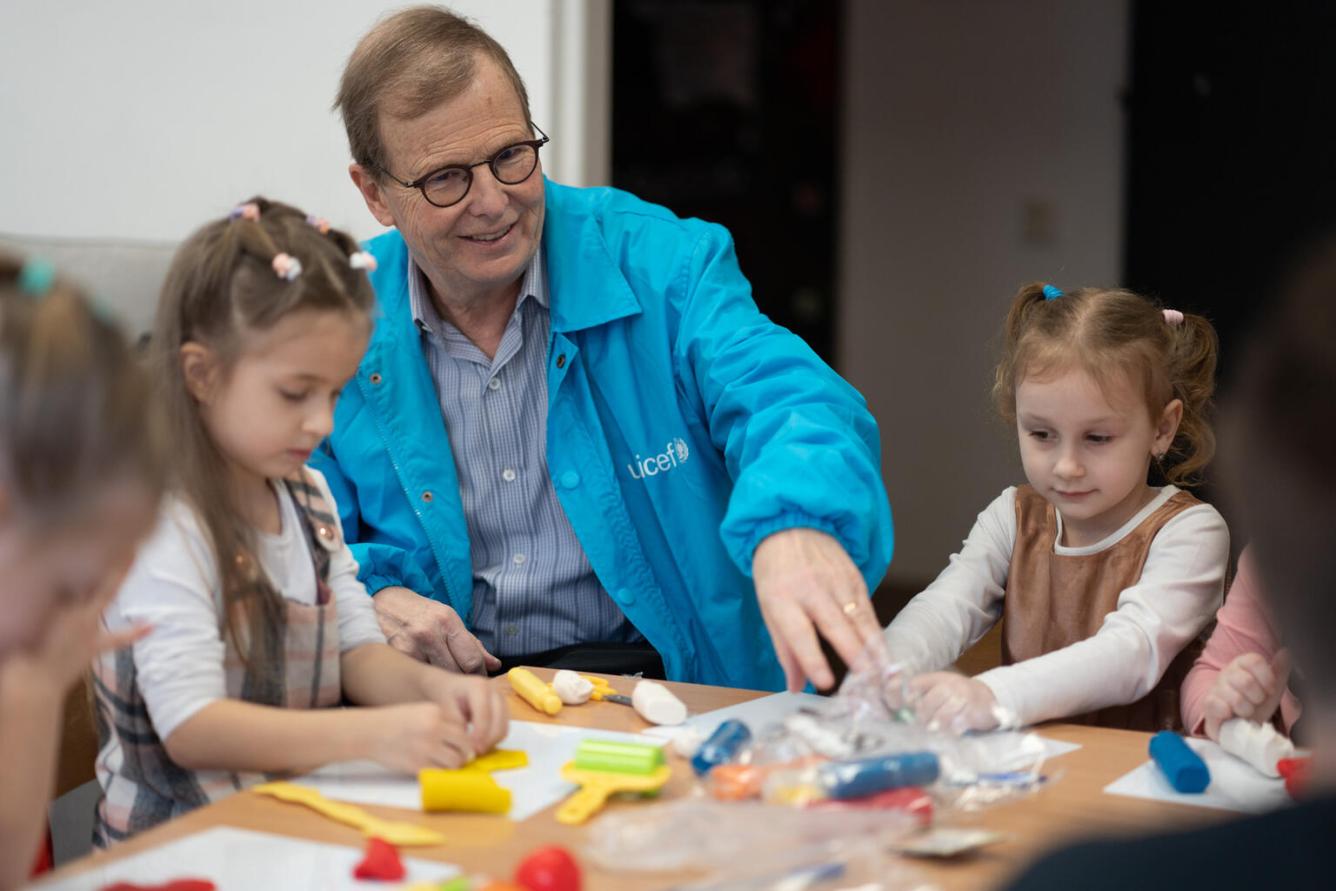A safe harbour for Ukrainians in Slovakia
By David Morley, President and CEO, UNICEF Canada
In January 2023, UNICEF Canada’s President and CEO David Morley, visited Slovakia and witnessed the work being done by UNICEF in supporting children and families who have fled the war in Ukraine. Below are some of his thoughts from the visit.
Bratislava, Slovakia: “We call ourselves Mareena for three reasons,” said Marta as we stood in their active little office with Slovak and Ukrainian social workers problem-solving with Ukrainian mothers who fled here after the war escalated last February.
“First of all, Marína is a famous Slovak poem of love. Then, because we first started our work helping refugees during the Syrian refugee crisis we changed the ‘i’ to ‘ee’ because it is more Arabic. And the word has a good meaning, it’s like,” she paused and searched for the English word. “Safe harbour” her colleague, Clara, said.
“Yes, safe harbour.” And that, I thought, is just what they are providing here.
Almost 100,000 Ukrainians have looked for safe harbour here in Slovakia, and 1,000 have found it here at the Gabçikovo Accommodation Centre. This large apartment block was built to house the workers who built the massive Gabçikovo Dam. It was vacant for many years (the dam was finished in 1996) but now provides shelter for 1,000 Ukrainians – mostly women and children.
Access to education for all children
UNICEF provides support to Mareena here. We help with education, providing pre-school and kindergarten. We have been helping with language textbooks, too. There is not a great call for Slovak as a second language up to now, I was told by Hsiao-Chen Lin, UNICEF’s Early Childhood Development Specialist, and even though Ukrainian and Slovak are close, they are different languages using different alphabets and so developing Slovak as a second language for kids is important.
The dilemma I have seen in so many countries regarding children and education happens in Slovakia too. Do local schools have room for a sudden increase in students? If the children learn in Slovak, does that mean they are staying here and will never return to Ukraine? However, if they learn only in Ukrainian, then they become segregated from the society where they are now living. The families here come from Eastern Ukraine, which is still a war zone, so how can they go home? The Ukrainian Ministry of Education does not want to lose so many children, so they have been encouraging online learning in Ukrainian. The escalation of the war and the more frequent blackouts mean that the online portals are often down and then the children have nothing.
Working through trauma

The trauma of the war is always there. “For many of the little ones,” sighed Carla, “it seemed their imagination was squeezed out of them by the war. When we first gave them crayons and paper to draw, they couldn’t think what to draw. Now they are drawing different things, their imagination is taking flight once again.” It has been particularly hard on the teenage boys. Since their fathers stayed behind in Ukraine, the boys are feeling the responsibility of being the head of the household. Even if they wanted to return to Ukraine, their mothers don’t want them to go. Every single family decision is hard, fraught, and loaded.
I am glad that the families have people like the women of Mareena to help make this harbour a little safer as they make their way through this terrible time.
Providing safety at Blue Dot Centres
Blue Dots are safe spaces along border crossings that provide children and families with critical information and services. There are three of them in Slovakia to support families escaping the Ukraine war, and the services at the Blue Dots are impressive. This one in the centre of Bratislava is right next to the bus station, so people can find it as soon as they arrive here. It is well organized and spacious, housed in a former shopping centre. You come in and get registered into the Slovak social system, there is housing advice, legal aid, volunteers teaching conversational Slovak, a clinic, an employment board and, tucked away from the hustle and bustle, a quiet room where children can play – including a Brio wooden train set just like our grandchildren enjoy (as did our children, and me, before them).
“These reception centres were started by volunteers,” Zuzana, the Slovak psychologist who leads our mental health work, told me. “When people began fleeing Ukraine, they gathered in the train stations. They didn’t know how long the war would last; they didn’t know where they were going. However, Slovak volunteers went to help. There was even a cavalcade of volunteer bus drivers who took their busses to the border to bring the refugees here to Bratislava.” Zuzana was involved in training border police on how to prevent child trafficking.
Building a sustainable system
The national and municipal governments joined in the effort, making it easy for Ukrainians to work and live – although many professionals – doctors, nurses, teachers – don’t have their Ukrainian professional designations recognized in Slovakia. “That’s a waste of talent,” muttered Zuzana. “We could use them in our system, but some of them are able to help out in our programs.”
But of course, 100,000 Ukrainians living in a country without a history of immigration at scale soon became too much for the volunteers. The involvement of the local government became vital to the sustainability of this work, even though it is an entirely new situation for them. Therefore, UNICEF provides support to the government and the local community groups who are leading the effort.
“The local government is a key to making all this sustainable,” said Michaela, a passionate advocate for children who leads UNICEF’s effort here. “They can coordinate these efforts, they can provide funds, and they can help turn these efforts from a one-time reception centre into an ongoing integration centre. Because I think we all know that this refugee crisis will not be the last one the country faces.”
Making this sustainable is what we must do. Since much of this outreach is new to Slovakia, we can help. “I knew UNICEF was powerful,” said Zuzana, “but now I see how our organization unites people – from the President to the forgotten Roma children.” Moreover, we’ve been building community integration programs around the country where young Slovaks, Ukrainians and Roma come together to volunteer at senior centres in different parts of the country. “Not only do these kids get to be the helpers instead of always being helped, everyone can see how they are contributing to society. That is building for the future.”
A hopeful departure

I leave this short visit impressed. Impressed with the way Slovak society is responding to the crisis, by the people I have met at the community and reception centres, helping the newcomers adjust to the unimaginable tragedy, which has uprooted their lives. Impressed by the commitment of the UNICEF team who are working so hard to make sure this work will last after we are gone. And of course, incredibly impressed by the spirit and strength of the refugees as they try to find a way forward in the maelstrom which has destroyed their community in Ukraine and totally disrupted their lives. If we can, in any way, help them through this time of unimaginable loss, then I think we must.
